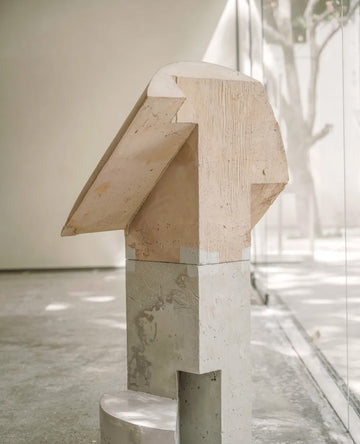

Ten Clouds
“How to achieve interaction between space, form, materials, architecture, and sculpture in an urban environment?” It seems that YEARLY PLAN HOUSE and Jen Aitken are aligned in their intuitive understanding of this proposition. Taking modernist style as its starting point, LINFORNI GALLERY teamed up with Canadian contemporary sculptor Jen Aitken to use modern apartment buildings as containers for thinking and observation.
Jen Aitken's sculptures are characterized by their minimal yet thought-provoking forms, which captivate the viewer while resisting easy identification. They surprise and confound with ambiguous meanings. Aitken deliberately emphasizes the hollow spaces within her works, infusing these spaces with energy through her choice of materials. This approach accelerates viewers' awareness of spatial relationships between themselves and the artwork, or between the artwork and its architectural environment.

Jen Aitken
Jen Aitken, based in Canada, is renowned in the contemporary art scene for her work in both sculpture and drawing. Her pieces strike a delicate balance between perceptual ambiguity and structural clarity, often using distinct industrial materials such as concrete, ceramics, metal, or wood to explore reflections on space and time.




Q&A
YEARLY PLAN HOUSE=YP
Jen Aitken=JA
In a short interview about the exhibition planning and the meaning of the sculpture, Jen Aitken shared with us her original concept for curating this exhibition, and the inspiration that YEARLY PLAN HOUSE once again gave her.
YP: For your first time in the Asian market, what were your considerations for your first exhibition in China at LINFORNI GALLERY? What kind of inspiration did you get from this modern space of YEARLY PLAN HOUSE?
JA: I was immediately struck by the affinity between my sculptures and YEARLY PLAN HOUSE’s sense of design, whether it be YEARLY PLAN's clothing or the architecture of the new retail and exhibition space. I was drawn to the clarity of the design of the entire YEARLY PLAN HOUSE building, the proportion of the clothing to the human body, and the warm and tactile materials used throughout the space. I immediately imagined that my sculptures would have a special 'voice' in this space. I like gallery spaces that are like white boxes, but I am also interested in how sculptures interact with other kinds of objects and what happens when exhibitions take place in spaces that are not just for art.
YP: What is the chemical reaction you feel between your work and YEARLY PLAN HOUSE? What kind of experience do you hope to present with the gallery in your first exhibition in Asia?
JA: I see a common interest in texture, authenticity of materials and the relationship between clothing and the body in my work and in YEARLY PLAN HOUSE. I look forward to a visual dialogue between architecture, clothing and sculpture. The YEARLY PLAN brand gives me a sense of quiet space that permeates my practice. Sometimes this is mistaken for 'cold' minimalism, but it is actually a deep appreciation for subtlety, honesty, depth and knowing how to slow down time.
YP: This is the first time you have exhibited in China. What considerations went into the selection of the ten works for this exhibition?
JA: I called the exhibition 'Ten Clouds'. This is because there are ten sculptures in the exhibition, each of which is like a fantasy that has changed form. Five of the sculptures are made of cast concrete - a material that is certainly not very cloud-like. But the form of these works gives them a soft, weightless quality. The concrete sculptures relate to the concrete used in the YEARLY PLAN HOUSE building and emphasise the sculptural nature of the architecture. The other five tabletop works in the exhibition are made from welded steel and ceramic slabs. They are arranged in abstract forms that resemble architectural models. The transformation of scale and material engages the viewer in a more subtle and intimate way.
YP: What kind of brand do you think YEARLY PLAN is? Is its style in line with your personal expression? How do you feel about the brand concept, the space and the fashion under the brand style?
JA: I like the modern simplicity and relaxed restraint of YEARLY PLAN clothing. There is a wealth of layers in the transitions between textures and the combination of silhouettes. By avoiding a lot of highly saturated colours, these transitions and combinations give minimalist clothing a sense of confidence and everyday relevance. The loose but precise proportions of the garments and the body are truly comfortable.
YP: Finally, please tell us something personal about architecture, life, etc.
JA: Before studying art, I studied fashion design at the City University of Toronto. I see clothing design and architectural design as creative processes with similar processes - the transformation of two-dimensional forms into three-dimensional forms that surround and serve the human body. Sculpture has given me a freedom I haven't found in design, but my desire for form and material is not selective.


